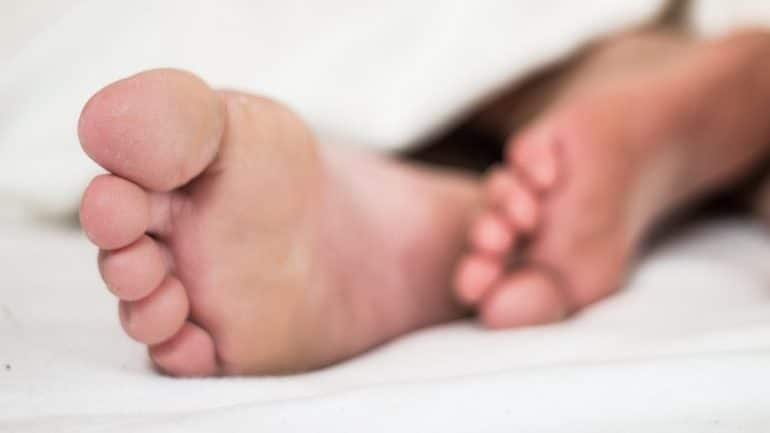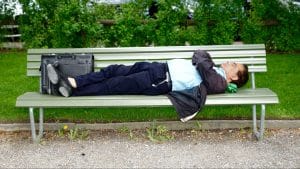The Best Restless Legs Syndrome Treatment Options
written by / August 13, 2019

Restless legs syndrome (RLS) is a nervous system disease characterized by the unpleasant sensation of pulling, pulsating, tingling, or crawling in the lower limbs. These complaints are accompanied by a strong, often overwhelming desire to move. Movement, in turn, helps relieve these symptoms.
Restless legs syndrome treatment is of the utmost importance. Since RLS occurs at night, and increases in intensity while your body’s at rest, it can severely disrupt your quality of sleep. Depending on the severity of the symptoms, RLS can also have a clear negative impact on a person’s daily functional activities.
What Causes Restless Legs Syndrome?
Given the manifestations associated with the disease, restless legs syndrome is attributed to movement disorders during sleep. However, a single specific cause has not yet been identified. According to experts in neurology who’ve studied restless legs syndrome for years, it’s a genetically conditioned neurological disease that’s marked by a chemical imbalance in the central nervous system.
In the case of restless legs syndrome, the causes and treatment go hand in hand. Because the problem is purely neurological, the effects of treatment occur quickly in most cases.
However, the etiology and pathophysiology of RLS are very complex, and various factors play a role. The most recent explanation for the causes of the disease can be found in the so-called iron-dopamine model. A connection with dopamine reception has been confirmed—patients suffering from restless legs saw relief after the administration of dopamine agonist. Further proof of this hypothesis is the syndrome’s presence in Parkinson’s disease patients—who also have a dopamine deficiency.
Low levels of iron in the cerebrospinal fluid are likely to cause a dysfunction in the dopaminergic system, which could be the underlying pathophysiological basis of RLS. The possible problem could be attributed to impaired transport and storage of iron in the basal ganglia, which is indirectly related to dopamine mediation. Patients suffering from restless legs note magnesium and folic acid deficiencies, along with the expected low iron symptoms. The former is especially typical for people who have kidney disease.
It’s also been assumed that genetic factors play a role in the chance of someone having the syndrome. There have been observed cases of patients under the age of 40 noting a family connection.
Other Possible Causes of RLS
Aside from the verified causes we’ve already mentioned, there are a few more possibilities for what triggers restless legs syndrome. Although there isn’t yet a proven link to the disease, the following may also play a role:
- Chronic diseases, such as diabetes mellitus, renal failure, and peripheral neuropathy, may be involved. Treatment for certain underlying conditions has led to symptom relief.
- There seems to be a higher risk with specific medications, including certain antiemetic, antipsychotic, antidepressant, allergy, and cold medicines.
- With restless legs syndrome, pregnancy, especially in the last trimester, could be related. In the case of pregnancy, RLS’s symptoms usually cease approximately four weeks after birth.
- Alcohol and sleep deprivation could also be a factor.
What Are the Restless Legs Syndrome Symptoms?
The disease has a progressive course, with some patients experiencing long symptom-free periods, followed by a new onset of complaints. Several main features characterize the disease:
- An unpleasant feeling in the feet is common, often while resting in a sitting or lying position. There’s also a prevalence of leg twitching. And occasionally, the arms or hands may be affected.
- Patients experience a robust, often overwhelming desire to move their legs. This could manifest as continuously moving the legs in a sitting position or frequently tossing and turning in bed. Luckily, movement leads to instant relief for restless legs.
- The symptoms are more common at night, and they’ll usually disappear or significantly diminish in the early morning hours.
- The symptoms can worsen during prolonged immobilization—for example, long journeys—as well as sleep deprivation, making it even harder to get the right amount of sleep.
The syndrome often combines with the so-called periodic movement of the limbs (80% of patients experience involuntary movements of the legs while asleep). In addition, studies show that caffeine increases a patient’s chance of their legs twitching in their sleep.
But how do you fall asleep with restless legs? Indeed, lasting an average of 20–40 seconds, RLS can disturb your sleep structure and even wake you up. This means patients are also likely to have problems with daytime sleepiness. In some cases, the syndrome is linked to severe symptomatic and untreated physical and mental exhaustion, depression, and other related concerns.
How Do You Diagnose RLS?

There’s no specific test or examination that can prove the diagnosis. In most cases, it’s based on a clinical evaluation and the exclusion of any other possible causes. This means that before being prescribed an effective restless legs syndrome medication, some illnesses—such as Parkinson’s disease, diabetes, fibromyalgia, and various joint or muscle disorders—will have to be excluded.
However, a polysomnographic study in a sleep research laboratory could be conducted. Some sleep specialists consider this test the gold standard for diagnosing the syndrome. Additional laboratory tests will be needed to exclude the diseases mentioned above.
Using the polysomnographic study, we can monitor a patient’s periodic limb movements during sleep to calculate an appropriate index of movement. In addition to its diagnostic value, the test also serves to individualize treatment and then monitor its effect.
But is restless legs syndrome serious? Well, the syndrome isn’t a life-threatening problem, though it does impair quality of life. It’s important to know that these symptoms may also suggest early kidney disease, diabetes, Parkinson’s disease, or deep vein thrombosis, sciatica, or other neurological disorders.
A statistical study in the US shows that the disease affects about 10% of the population, both in childhood and adulthood. Usually, restless legs at night occur among people over the age of 30, with the symptoms increasing as they get older. Old age and the presence of concomitant diseases are associated with more severe RLS occurrences, with symptoms appearing more frequently and for a longer duration. The syndrome can affect both men and women, but the incidence rate among women has been observed to be twice as high.
What’s the Treatment for Restless Legs Syndrome?
There is no universal cure for the disease. Treatment is challenging and usually doesn’t provide long-lasting results. Initially, a patient will be advised to make some changes in their lifestyle—like avoiding smoking, drinking alcohol, or consuming caffeinated beverages. According to several specialists, these will further aggravate symptoms.
A patient usually only requires a drug-based RLS treatment when it becomes clear that their quality of life has been impaired as a result of pronounced sensory and motor symptoms, as well as sleep disturbances. The treatment that will then be administered depends on the type of disease and the polysomnographic analysis.
Treatment for RLS may include dopamine agonists, anticonvulsants (gabapentin and pregabalin), benzodiazepines, or opioids to calm the sensory sensations. In most cases, these will suppress the patient’s symptoms. However, it’s essential that the various medications are dosed correctly.
Since the disease’s symptoms intensify at night, it can harm and worsen your sleep, leading to insomnia. It’s hard for patients to avoid wondering what stops restless legs syndrome. However, the severe discomfort or numbness in the limbs can be alleviated by massaging the legs or moving them until the feeling stops. Also, some patients claim that a weighted blanket alleviates their symptoms.
The primary drug that controls RLS’s clinical symptoms is clonazepam because it stabilizes the transmission of nerve impulses. Suitable medications are also carbidopa and levodopa, which are also used to treat Parkinson’s. Other drugs that control the clinical symptoms are the sedatives methadone and codeine. However, restless legs syndrome treatment guidelines only suggest use of the latter in extreme cases because they can cause severe dependency in patients.
Alternatives to Medications

Sleep aids and muscle relaxants can help you fall asleep more naturally in the evening, but they won’t eliminate the unpleasant sensations. Furthermore, they sometimes cause daytime sleepiness or other side effects without giving patients any long-term benefits or RLS symptom relief. Nevertheless, in most cases, the feeling of jumpy legs can be controlled with some light medicines as well as some exercises.
Nutritionists also suggest taking vitamins for restless legs. Specifically, you can enrich your daily menu with some nutritional supplements containing blue-green algae, which normalizes nutritional deficiencies due to its rich range of dietary micronutrients. According to nutritionists, you should add foods rich in fiber, iron, vitamin B-complex, vitamin E, or multivitamins to your diet. In the case of a folic acid deficiency, doctors recommend taking between 400 and 1000 µg of folic acid daily.
An RLS treatment with herbs to relieve muscle tension and leg pain at night can include passionflower, valerian, and black cohosh. Extracts of Viburnum opulus and herbal antispasmodics can also be practical and long-lasting solutions to the problem. Remember to consult your doctor before taking any herbs to treat the condition.
The misconception that excessive movement can worsen the condition is widespread. In fact, the opposite is true—immobilization provokes the unpleasant sensations related to the syndrome. This is why RLS often happens on a long flight, in a movie, or in a confined space.
What Is the Best Home Remedy for Restless Legs Syndrome?
Frankly, the best recommended home remedy is making lifestyle changes. No matter your age, it’s never too late to improve your motor habits and physical activity and break the vicious cycle of inactivity. In addition, if there are other accompanying diseases that aggravate the clinical manifestations of RLS, they will need to be addressed.
If you want to know how to get rid of restless legs fast, a proven method is applying warm and cold compresses. This gives temporary but immediate relief in your aching legs when you’re lying down.
Keeping yourself entertained just before bedtime also helps—boredom and drowsiness can exacerbate the symptoms. This can be done by reading a book, watching a movie, playing games, or maybe solving a crossword puzzle. Drinking warm tea or a similar hot drink is another effective RLS natural treatment. But avoid eating within a few hours of going to bed.
Once you’re ready to go to sleep, your bedroom should be as quiet as possible, at the optimal temperature, with no TV or computer nearby. Sometimes, sleeping with socks can significantly relieve your symptoms and improve your sleep—probably because this RLS home treatment keeps the feet warm and protected.
To help you consistently fall asleep in the evening, keep a regular bedtime, use the bed just for sleep, and maybe follow a relaxation technique, like meditation or yoga. Simply maintaining healthy sleep habits can reduce the syndrome’s episodes. You might want to start following certain “rituals”—such as taking a hot bath, watching a film, or listening to music—to help your body adjust to sleep.
Other methods such as acupressure and homeopathy are broadly used as a restless legs syndrome natural treatment meant to reduce any pain in the legs at night. However, they are not necessarily recommended because there isn’t enough scientific proof demonstrating their efficacy.
No matter what, it’s best to find a system that works best for you. To do this, you may even want to keep a diary to keep track of what’s obstructing and aiding your sleep.
FAQs
Do bananas help with restless legs syndrome?
Potassium plays a critical role both in sending nerve impulses and in muscle contraction. As bananas are a superb source of potassium, consuming these fruits could help calm your restless legs. However, bananas are not the only significant source of potassium, if you don’t like them. Nevertheless, bananas are brilliant for your nervous and muscle systems, even if you don’t have RLS.
Does taking magnesium help restless legs?
Even assuming the hypothesis that RLS is caused by a magnesium deficiency is true, it isn’t clear whether magnesium supplements can improve the symptoms. However, some earlier studies indicate that they have some beneficial effects when administered as an alternative therapy for mild or moderate RLS. Anyway, magnesium oil applied directly onto the legs could also potentially improve some of the disagreeable sensations.
Can CBD oil help with restless legs syndrome?
It’s been shown that a sublingual cannabis-based spray containing CBD and THC helped around half of the RLS patients who tried it. Cannabis and CBD have been used to treat insomnia, especially CBD oil, which often delivers a sedative effect to users. However, CBD oil itself cannot reliably treat RLS, considering that half of the patients saw no effect at all.
Conclusion
Restless legs syndrome is one of the many so-called sleep disorders—a large group of diseases whose diagnosis has been actively developed in recent years on a global scale. RLS falls into this category because it impacts the circadian (24-hour) rhythm and occurs mainly at rest—resulting in severe sleep disturbances. An effective restless legs syndrome treatment, however, can allow patients to have a qualitative sleep for the first time after what may be years of suffering and discomfort.









Warning: Undefined array key "format" in /home/602518.cloudwaysapps.com/cspedpjass/public_html/wp-content/themes/disturbmenot/template-parts/post-item/post-comment.php on line 23
Warning: Undefined variable $commenter in /home/602518.cloudwaysapps.com/cspedpjass/public_html/wp-content/themes/disturbmenot/template-parts/post-item/post-comment.php on line 27
Warning: Trying to access array offset on value of type null in /home/602518.cloudwaysapps.com/cspedpjass/public_html/wp-content/themes/disturbmenot/template-parts/post-item/post-comment.php on line 27
Warning: Undefined variable $commenter in /home/602518.cloudwaysapps.com/cspedpjass/public_html/wp-content/themes/disturbmenot/template-parts/post-item/post-comment.php on line 29
Warning: Trying to access array offset on value of type null in /home/602518.cloudwaysapps.com/cspedpjass/public_html/wp-content/themes/disturbmenot/template-parts/post-item/post-comment.php on line 29